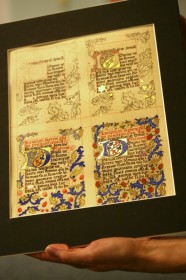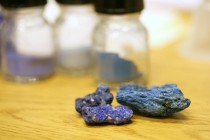The Art of Illumination
How were books made before the invention of Gutenberg's printing press? Completely by hand. Every letter, every picture, every page, every color of paint, every quill pen and every paintbrush. Books were expensive. The finest and most beautiful books, Bibles, prayer books, and Books of Hours, could cost as much as $50,000 - $70,000 in today's currency. Royalty, wealthy clergy, and churches had books. Few other people could read.

Dr. Tony Silvestri's hand-made illuminated manuscript shows the steps in making an illuminated page, using the techniques of the medieval artists.
The pictures in books were called illuminations. Washburn University's Dr. Tony Silvestri gave a fascinating talk on Illuminated Manuscripts, his research specialty. Dr. Silvestri has researched and practiced the art of illumination for years, and his talk at the library covered the steps and materials involved in this centuries-old art.
To cut down on errors, book makers had a process: first, the scribe copied the text. It's easier for a scribe to make an error - a misspelling, or missing a line - than it is for an artist to make an error in a drawing. The artist has more opportunity to correct a line, or change the drawing to fit. The second step is to place the gold leaf. Then, the artists get the pages to do the drawings in some of the capital letters, or along the borders of the page, or the larger drawings that might start a chapter. Even the artists had specialties: one person did the figures, another the leaves, another the strawberries, another the scrollworks.
The artists couldn't go out and buy paint - they could buy pigments.
Dirt, plants, minerals, insects and alchemical formulas, ground into powder, would be mixed with water, alcohol or oils to make paint. Dr. Silvestri shared his translation of Cennino Cennini's how-to book from the 14th century - a handbook for artists on how to grind and blend paints -- or better yet, make your apprentice do it. Il libro dell'arte includes tips on what pigments are easier to find and grind yourself, and which you should just go and buy.
Dr. Silvestri has been making illuminated manuscripts using these traditional and historic techniques for years. He began researching the topic for his PhD dissertation.

















